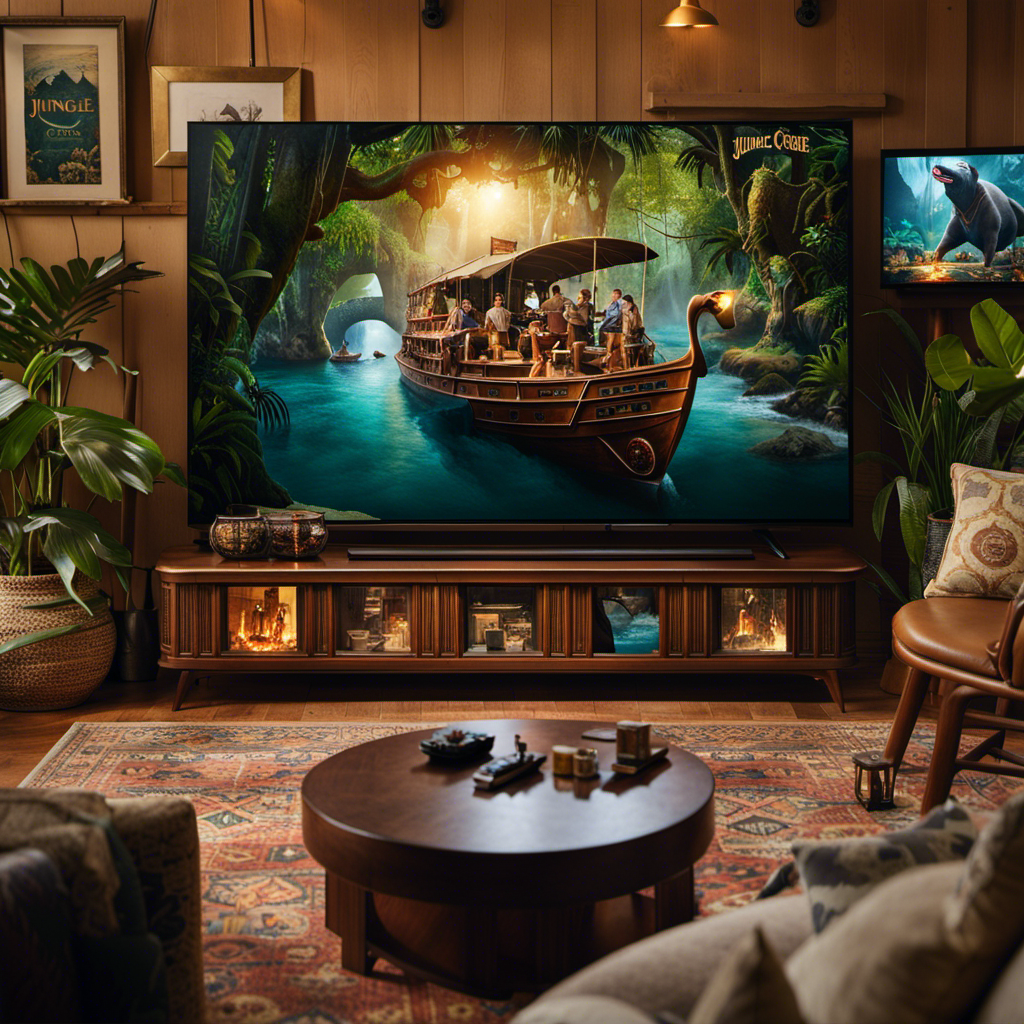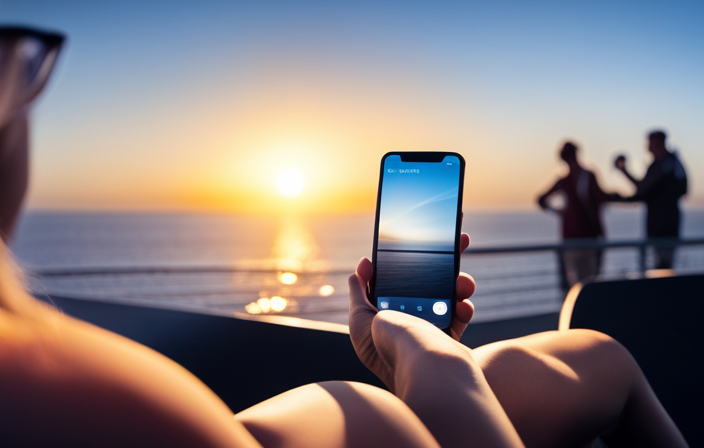Imagine stepping onto a luxurious cruise ship, ready to embark on a journey filled with relaxation and adventure. As you settle into your cabin and unpack your belongings, you may wonder why there are no surge protectors available for use aboard. Indeed, in our modern, technology-driven world, our reliance on electronic devices is considerable.
Well, I’m here to shed some light on this intriguing question.
In order to ensure the safety of passengers and crew members alike, cruise ships operate under strict regulations when it comes to electrical systems. While surge protectors may seem like a simple solution for preventing power surges and potential damage to our beloved gadgets, they actually pose certain hazards that can compromise the integrity of the ship’s electrical infrastructure.
Join me as we delve into the world of cruise ship safety regulations and explore alternative measures implemented to safeguard against power surges at sea. Let’s uncover the reasons behind this seemingly curious absence of surge protectors and gain a deeper understanding of how our electrical safety is prioritized while cruising the open waters.
Key Takeaways
- Cruise ship operators take extensive measures to prevent power surges and have their own built-in surge protection mechanisms.
- Using surge protectors on cruise ships may interfere with the ship’s electrical system and lead to malfunctions or disruptions.
- Passengers can reduce the risk of electrical incidents by following crew guidelines for proper use of electrical devices and avoiding misuse or overloading of outlets.
- Maintaining a safe and functional electrical system on cruise ships requires prompt reporting of any electrical issues by passengers, which contributes to a proactive approach in resolving concerns.
Safety Regulations on Cruise Ships
One possible reason for the absence of surge protectors on cruise ships could be that safety regulations prioritize other measures to ensure passenger well-being. Safety precautions on cruise ships address a wide range of potential hazards, including fire safety and emergency response protocols.
These regulations may focus more on electrical system maintenance rather than relying solely on surge protectors. Cruise ships have intricate electrical systems that require regular inspections and maintenance to ensure safe operation. By adhering strictly to these guidelines, cruise ship operators can minimize the risk of electrical malfunctions and subsequent power surges.
However, it is important to consider the potential hazards of surge protectors as well. The subsequent section will discuss their usage onboard cruise ships.
Potential Hazards of Surge Protectors
When it comes to surge protectors on cruise ships, there are actually potential dangers and electrical hazards associated with their use. Surge protectors often have a high level of voltage protection, which can cause issues when plugged into an already protected system on board a ship. This can lead to power overload and even fires in extreme cases.
Additionally, surge protectors may not be compatible with the ship’s electrical system, resulting in damage to both the device and the ship’s infrastructure. Given these potential hazards, cruise ships implement alternative measures for electrical safety, such as using circuit breakers and grounding systems to ensure the protection of passengers and crew members alike.
Alternative Measures for Electrical Safety
When it comes to electrical safety, there are alternative measures that can be implemented aside from surge protectors.
One such measure is the use of ground-fault circuit interrupters (GFCIs), which are designed to detect any imbalance in the electrical current and quickly shut off power to prevent potential hazards.
Additionally, regular inspections and maintenance protocols should be followed to ensure that all electrical systems and equipment are in proper working order, minimizing the risk of accidents or malfunctions.
These measures play a crucial role in maintaining a safe environment and preventing electrical mishaps.
Ground-fault circuit interrupters (GFCIs)
To truly understand the importance of ground-fault circuit interrupters (GFCIs) on cruise ships, you must grasp how these devices can prevent electrical shocks and potential disasters.
GFCIs are highly effective in safeguarding against electrical accidents by constantly monitoring the flow of electricity. They work by quickly detecting any imbalance in current between the hot and neutral wires, shutting off power within milliseconds to prevent electrocution.
This effectiveness is crucial for ensuring the safety of passengers and crew members onboard. By promptly interrupting faulty circuits, GFCIs minimize the risk of electric shock injuries or even fires caused by short circuits or damaged wiring.
Incorporating GFCIs into a ship’s electrical system is an essential part of prioritizing electrical safety. However, inspections and maintenance protocols are equally important to ensure that these devices continue to perform optimally and protect against potential hazards without interruption.
Inspections and maintenance protocols
Regularly inspect and maintain the ground-fault circuit interrupters (GFCIs) on your vessel to ensure they are functioning properly and protecting against potential electrical hazards.
Last year, there was a faulty wiring incident on another ship that resulted in multiple injuries, highlighting the importance of inspections and maintenance protocols.
Effective inspections involve thorough checks of all GFCIs onboard, testing their effectiveness in detecting faults and tripping the circuit.
The frequency of maintenance should be determined based on manufacturer recommendations and industry standards.
By staying proactive with inspections and adhering to regular maintenance schedules, we can minimize the risk of electrical accidents on cruise ships.
Moving forward, let’s discuss power outlets and voltage on cruise ships to further understand how electrical safety is maintained throughout the entire vessel.
Power Outlets and Voltage on Cruise Ships
Despite the limited availability of power outlets and unpredictable voltage on cruise ships, passengers are left feeling frustrated and powerless.
It is not uncommon to find only a few power outlets in cabins or shared spaces, making it difficult for passengers to charge their devices or use electrical appliances simultaneously.
Additionally, the voltage on cruise ships can vary depending on the location and the ship’s power source. This inconsistency poses a challenge for passengers who may need voltage converters to safely use their electronic devices onboard.
-
The scarcity of power outlets forces passengers to prioritize which devices they can charge, causing inconvenience and frustration.
-
Unpredictable voltage levels increase the risk of damaging sensitive electronics or rendering them useless.
-
Limited access to power outlets hinders productivity for those who rely on their laptops or other electronic equipment while at sea.
The next section will address the potential dangers of power surges at sea, highlighting why surge protectors are essential onboard cruise ships.
Power Surge Risks at Sea
Beware the treacherous waters of power surges at sea, where rogue currents threaten to engulf your delicate electronics in a raging storm. Power surge risks on cruise ships are a serious concern due to their potential to damage electrical equipment and disrupt onboard systems.
To prevent such incidents, various power surge prevention methods are implemented, including voltage regulators and isolation transformers. These devices help stabilize the fluctuating voltage levels often encountered at sea, safeguarding sensitive electronics from sudden spikes in power.
Additionally, the importance of electrical safety training cannot be overstated. Crew members undergo rigorous training programs to ensure they understand the risks associated with power surges and are equipped with knowledge on how to handle electrical issues safely.
By implementing these preventive measures and providing proper training, cruise ships aim to minimize the chances of power surges occurring onboard.
Transitioning into liability and insurance considerations, it is crucial for cruise ship operators to carefully assess their responsibilities in case of any electrical mishap without compromising passenger safety or experience.
Liability and Insurance Considerations
Cruise ship operators carefully assess their responsibilities in case of any electrical mishap, ensuring both passenger safety and a seamless experience. When it comes to liability considerations, cruise ship operators understand the potential risks associated with power surges at sea. They are well aware of the damages that can occur to passengers’ personal belongings or even the ship’s electrical systems during such incidents.
To protect themselves from potential lawsuits, cruise lines typically have comprehensive insurance policies in place that cover these types of accidents. These policies not only provide financial protection but also help maintain the reputation and trust of passengers in the company’s commitment to their safety. Understanding these liability considerations and having appropriate insurance coverage is crucial for cruise ship operators to effectively manage any electrical mishaps on board.
Transitioning into the subsequent section about ‘passengers’ responsibility for electrical safety,’ it is important to note that while cruise ship operators take extensive measures to prevent power surges, passengers also play a significant role in ensuring their own safety onboard.
Passengers’ Responsibility for Electrical Safety
When it comes to electrical safety on a cruise ship, passengers have a responsibility to ensure the proper use of electrical devices. This means following guidelines provided by the crew and avoiding any misuse or overloading of outlets.
Additionally, if any electrical issues are noticed, it is important for passengers to promptly report them to the crew so that they can be addressed and resolved in a timely manner.
Proper use of electrical devices
Imagine enjoying the gentle sway of the ship as you lounge on the deck, surrounded by fellow passengers happily using their electrical devices without a worry. It’s important to understand that proper maintenance and awareness of electrical device limitations are crucial for ensuring safety on board cruise ships. To help you navigate this topic, I have created a table below outlining some key points to consider when using electrical devices at sea.
| Proper Maintenance | Electrical Device Limitations |
|---|---|
| Regularly check cords for fraying | Be mindful of power usage to avoid overloading outlets |
| Keep devices away from water | Avoid using high-powered appliances that may strain the system |
| Use surge protectors when available | Do not use damaged or faulty devices |
By following these guidelines, passengers can greatly reduce the risk of electrical incidents onboard. It is also essential to report any electrical issues to the crew promptly. This ensures that necessary actions can be taken swiftly, maintaining a safe environment for all passengers.
Reporting any electrical issues to the crew
To ensure a safe environment for everyone on board, it is crucial to promptly report any electrical issues you notice to the crew. This helps in maintaining the integrity of the ship’s electrical system and preventing potential hazards.
When reporting an issue, it is important to follow the designated reporting procedures established by the cruise line. Provide specific details such as the location of the problem and any visible signs of damage or malfunction. The crew takes these reports seriously and will respond promptly to address and resolve any electrical concerns.
Their response may involve troubleshooting, repairs, or even temporarily shutting down certain areas for maintenance if necessary. By reporting issues promptly, you contribute to a proactive approach in maintaining a safe and functional electrical system on board.
Transitioning into the next section about crew training and emergency procedures…
Crew Training and Emergency Procedures
Proper crew training and thorough emergency procedures ensure the safety of passengers on cruise ships. Crew communication protocols are essential in maintaining a safe environment onboard. From regular drills to clear communication channels, the crew is well-prepared to handle any emergency situation that may arise. Emergency response training equips crew members with the necessary skills to act swiftly and effectively during an incident.
To visualize the importance of crew training, imagine a 2 column and 3 row table. On one side, you have various emergency scenarios such as fires, medical emergencies, or even ship evacuation. On the other side, you have corresponding actions taken by trained crew members: immediate response, alerting appropriate authorities, implementing evacuation plans, and providing first aid.
The effectiveness of these protocols ensures that passengers are in capable hands throughout their journey. Transitioning into the subsequent section about electrical safety inspections on cruise ships, it is crucial to understand how these measures contribute to overall passenger security without compromising convenience or comfort.
Electrical Safety Inspections on Cruise Ships
The implementation of comprehensive electrical safety inspections ensures that cruise ship passengers are provided with a secure and reliable onboard environment. Cruise ships are equipped with complex electrical systems that power everything from lighting to navigation equipment.
To maintain the highest level of safety, these ships must adhere to stringent electrical safety standards. Regular inspections are conducted to identify any potential hazards or malfunctions in the electrical systems. These inspections involve thorough checks of wiring, circuit breakers, grounding systems, and other components to ensure they meet industry regulations.
By conducting these inspections, cruise ship operators can address any issues promptly and prevent accidents or disruptions caused by electrical failures. This commitment to maintaining a safe cruising experience for both passengers and crew is paramount in ensuring their overall well-being throughout their voyage.
Ensuring Passenger and Crew Safety
Imagine sailing on a floating fortress of safety, where every precaution is taken to ensure your well-being as a passenger or crew member. On cruise ships, passenger awareness and emergency preparedness are paramount. Here are four reasons why:
-
Safety drills: Cruise ships conduct mandatory safety drills for all passengers and crew members before departure. These drills familiarize everyone with emergency procedures and the locations of lifeboats and evacuation routes.
-
Trained staff: Cruise ships have trained personnel who are prepared to handle various emergencies such as medical incidents or fires. They undergo rigorous training to ensure they can respond effectively and efficiently in any situation.
-
Communication systems: Cruise ships are equipped with advanced communication systems that allow immediate contact with shore-based authorities in case of an emergency. This ensures that help can be quickly dispatched if needed.
-
Safety equipment: Cruise ships are stocked with state-of-the-art safety equipment, including fire suppression systems, smoke detectors, and life-saving devices like life jackets and rafts.
Passenger awareness and emergency preparedness remain top priorities on cruise ships, providing peace of mind for all onboard.
Frequently Asked Questions
Are surge protectors allowed on cruise ships?
Surge protectors are typically allowed on cruise ships, as regulations for other types of transportation permit their use. Surge protectors provide numerous benefits in residential settings, such as safeguarding electronic devices from power surges and preventing potential damage.
What are the potential consequences of using a surge protector on a cruise ship?
Using a surge protector on a cruise ship can be like adding fuel to a fire. The potential risks and electrical hazards it poses could lead to serious consequences, jeopardizing the safety of both passengers and the ship itself.
Are there any alternative measures for electrical safety that passengers can use instead of surge protectors?
There are alternative solutions to ensure electrical safety on cruise ships. Passengers can use power strips with built-in surge protection or portable ground fault circuit interrupters (GFCIs) for added protection.
What is the voltage and type of power outlets available on cruise ships?
The voltage on cruise ships varies, but most commonly it is 110V or 220V. Power outlets on cruise ships typically use the standard two-pronged North American or European style plugs, so plug adapters may be necessary for compatibility with other types of plugs.
Are power surges common on cruise ships and what risks do they pose to passengers and crew?
Power surges on cruise ships are uncommon due to power systems designed to prevent them. However, they can pose risks such as damage to electrical equipment and potential safety hazards. Stringent electrical safety measures are in place to minimize these risks for passengers and crew.
Conclusion
In conclusion, the absence of surge protectors on cruise ships symbolizes a larger issue at hand – the prioritization of passenger and crew safety.
While alternative measures are in place to mitigate electrical hazards, it is essential for both passengers and crew members to take responsibility for their own safety.
By adhering to proper training and emergency procedures, conducting regular inspections, and ensuring power outlets meet safety regulations, cruise lines can work towards creating a secure environment for all on board.
Only then can we truly guarantee a safe voyage for everyone involved.










